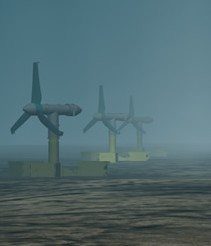Tim Cornelius has been working on tidal energy as CEO of Atlantis Resources for the better part of a decade, since soon after the company was first established in Australia in 2002. And the best sign for him that the technology is steadily marching towards deployment and then maturity is the growing interest of the world’s biggest industrial groups.
In the last year to 18 months, most of Atlantis Resources’ tidal technology rivals have been snapped up, in whole or in part, by some of the biggest names in industrial technology – Rolls Royce, Alstom, Hyundai, Kawasaki, Siemens, with a host of other Chinese groups on the sidelines. Atlantis itself has formed a strategic, although not equity, partnership with US defence giant Lockheed Martin, one of a number of defence contracting starting to specialise in the area, such as France’s DCNF and British Aerospace.
What’s the attraction? According to Cornelius, it’s an increasing realisation that tidal energy is a viable technology that will soon be cost competitive, at first with offshore wind energy and eventually with onshore wind, and that can be attractive to grid managers because of the wonderfully predictable nature of its power production. Tidal waves, however, are not baseload and will likely operate on capacity factors of 30-50 per cent.
Cornelius says that the coming year will be a critical one both for Atlantis, now based in Singapore for the want of any opportunities in tidal-rich Australia, and for the industry as a whole. Atlantis will soon become the first tidal energy developer to deploy at the massive National Renewable Energy Centre (Narec) near Newcastle in the UK, where its 1MW, 120-tonne turbine will undergo further testing before Lockheed is commissioned to produce the Mark II version, which will likely be deployed as part of a huge 400MW Meygen development in Scotland’s Pentland Firth.
Cornelius says the UK, Canada and other countries such as India will emerge as leaders in the technology because they are prepared to support the initial deployment. In the UK, tidal developments get a 5-times multiplier of the local equivalent of renewable energy certificates, and will soon be followed by Scotland. This adds revenue of around £250 to the normal “black energy” price. In Canada, a community tariff scheme is offering $C600/MWh for the initial deployment.
“This is attracting the big guys, and you want them to come in because they have got the money and the balance sheets, but they will use local companies and supply chains,” Cornelius told RenewEconomy in an interview. “And that has unleashed new capital. It’s been a very good shot in the arm for Atlantis’ business.”
In India, the government of Gujarat is also pushing tidal energy (along with solar thermal), reasoning that it would benefit from an indigenous energy resource and technology adoption. Atlantis Resources has a contract to build up to 250MW of tidal energy installations in the Gulf of Kutch with the Gujarat state government.
“They realize that the early stages are more expensive than thermal,” Cornelius says. But in the medium term, if you have got huge resources then as you roll them out it becomes a significant industry – it plays to their strengths, it becomes a new industry that becomes self funding, and self-reliant. They have had success with (wind energy manufacturer) Suzlon, now they are trying to replicate that in the tidal space.”
He says Atlantis Resources prefers to remain independent, at least at this stage, because it does not want to choose between an engineering company, a systems integrator, or a turbine producer. It prefers instead to find strategic partners like Lockheed. Its own share register is dominated by Morgan Stanley (49 per cent), along with Norway’s StatKraft and the Singapore government, amongst others. Goldman Sachs was last year retained to scope out “global supply chain” options, but nothing has yet been decided.
Cornelius says his company sees a lot of synergies between offshore wind and tidal energy (he describes the turbines as effectively an underwater windmill) – mostly through the sharing of infrastructure such as cabling. The interest from the defence contractors comes from their knowledge of sub-sea turbine systems.
Despite the fact that the company’s CEO, CTO and many of its engineers are Australia, Cornelius does not expect to see many opportunities emerge in his home country, despite its obvious resources. Areas in the north-west of WA and in the Northern Territory had excellent resources, and could find themselves in a hub of massive LNG developments, but it’s immediate prospects lie elsewhere.
“In Australia, there is no formal process. You need the longer term incentives. We’d love to do something at home. But at the moment, we have to be realistic. We have got a simple mandate, first to make sure that tidal energy is cost competitive with offshore wind, and then to show that it is competitive with onshore wind. We hope to do that within five years.”









